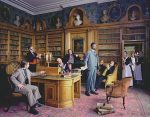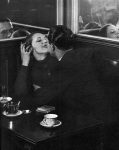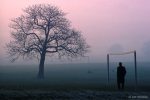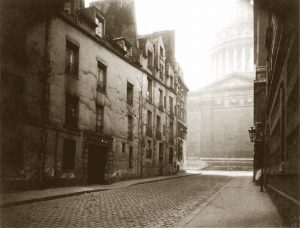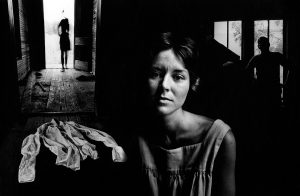- þ
Image 1: Thomas Knuebuhler “untitled #4” 2003. The clear, simplistic, and breadth of the photograph seems very empty, yet suggests the narrative of the countless individuals working/living/etc. in the building.
Image 2: Alex Prager “Susie and Friends” 2008. Prager’s photographs are often inspired by films such as Pulp Fiction, which is clear in the vibrant, busy photograph here, which invites the viewer to imagine a multitude of stories surrounding the subjects of the photograph.
Image 3: Hannah Starkey “Untitled” 2003. I like the painting-like quality of this photograph, which seems to play with the truth of the image before us, wavering between photography and painting. This quality also makes it difficult to first discern what we’re even seeing.
Image 4: Yeondoo Jung “Location #1” 2005. The construction of a stage in this image makes the viewer question the reality of everything else, playing into the preconceptions of theater and the stage.
Image 5: Rune Guneriussen “Bustle of plausible alliances” 2013. Guneriussen’s work constructs odd, yet beautiful structures in nature, which don’t look as if they would exist in reality, but they do, blurring the line between expected truth and the photograph.
Image 6: Marilyn Minter “Gasp” 2004. I love the visceral, gritty quality of these images, which seem almost unreal with the colors and items in the photograph. The viewer attempts to figure out the “truth” of what is happening in the photograph.
Image 7: Todd Hido. I love the creepy, lonely feeling of the photograph. Even though the image is of a house, a familiar, often “safe” object, the portrayal in this work seems unsettling and off.
Image 8: Philip-Lorca Dicorcia “W” 2000. This image is so driven by the color palette, which makes the truth of the photograph stretch, the viewer questions whether these people are in the same room/same time/etc.
Image 9: Yinka Shonibare “Diary of a Victorian Dandy 14:00 Hours” 1998. Similar to the last image, the painting-like quality of this photograph seems to stretch the truth, especially within a historical context. The image is full of narrative, with various elements and stories playing out at once.
Image 10: JR “Rooftops” in Women are Heroes 2009. This image is combination of photography in the real world being photographed. The truth of the unreal looking women on the rooftops pushes the viewer to question the reality of the image.









